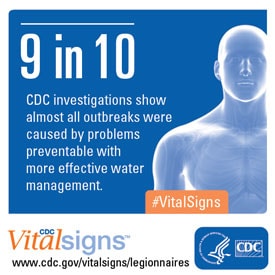Outbreaks
Legionnaires’ disease and Pontiac fever outbreaks occur when two or more people are exposed to Legionella in the same place and get sick at about the same time. People can get Legionnaires’ disease or Pontiac fever when they breathe in small droplets of water in the air that contain Legionella.
Outbreaks are commonly associated with buildings or structures that have complex water systems, like hotels and resorts, long-term care facilities, hospitals, and cruise ships. The most likely sources of infection include water used for showering, hot tubs, decorative fountains, and cooling towers (structures that contain water and a fan as part of centralized air cooling systems for a building or industrial processes).
Legionnaires’ disease and Pontiac fever outbreaks can be difficult to identify. Sometimes people travel to a common location, are exposed to Legionella, and then return home before becoming sick. State, territorial, and local health departments take the lead in investigating outbreaks. They also identify control measures to remove Legionella from the water identified as the source of infection. CDC is only involved in outbreak investigations when a health department requests additional assistance. State, territorial, and local health departments are the best source of information for a specific outbreak.
Learn more about how public health departments define Legionnaires’ disease outbreaks.

Clusters and outbreaks have the same definition and you can use either term. Both terms describe two or more people with Legionnaires’ disease exposed to Legionella at the same place at about the same time (as defined by the investigators). However, your target audience (e.g., the general public, the media, building owners/managers, healthcare facility staff) may perceive the terms differently. It is up to you to decide how to use these terms, but, whatever you choose, use the terms consistently.
